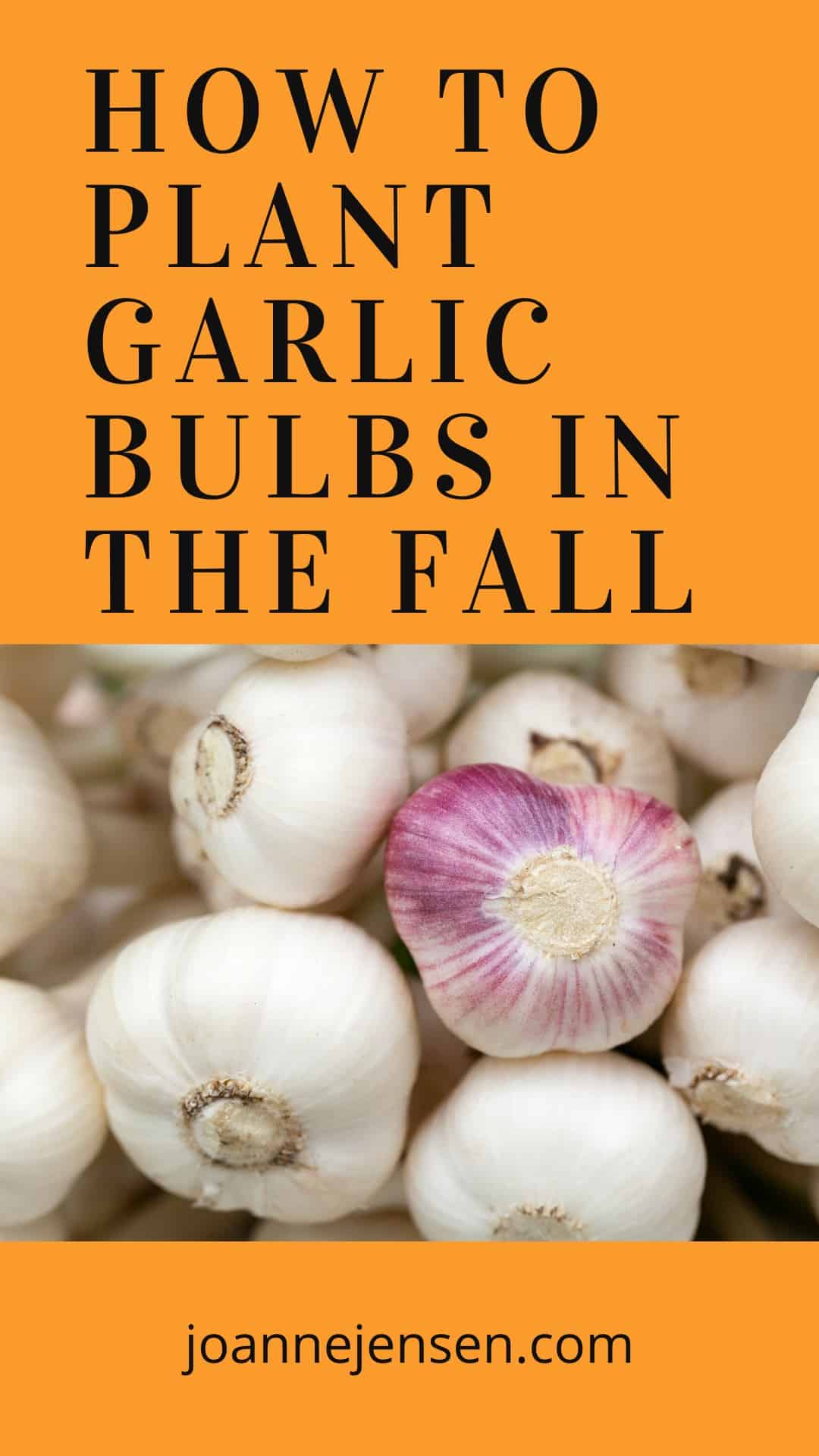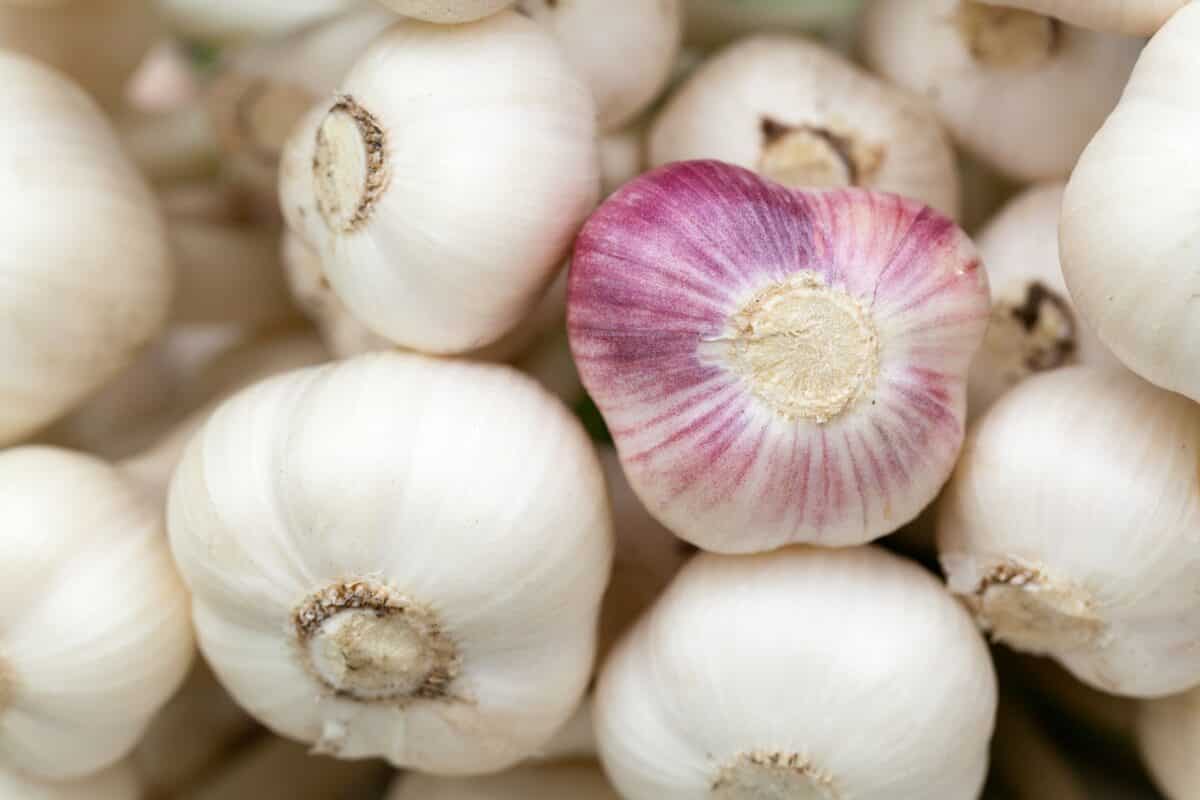How to Plant Garlic Successfully in The Fall Season
When planting individual cloves keep the peels intact, pointy end up, 2 inches deep and 6 inches apart. Also mulch 5-8 inches deep with seedless straw.
Over the Winter the mulch will reduce to about 2 inches by Spring and this will help to keep the weeds down during the growing season.
How Long Do You Soak Garlic Before Planting?
When planting garlic cloves you should soak for at least 30 minutes up to overnight. Many times we soak and are not able to plant the next day for various reasons, so leave them in the fertilization to soak up for up to 3 days.

How Do You Prepare Garlic for Soil?
To grow nice, big heads of garlic, you need loose, fertile soil. Loosen the soil with a digging fork, spread a 2- to 3-inch-deep layer of organic matter over the area, and dig it in.
For organic matter, I use a well-aged mixture of compost, leaf mold, and aged rabbit manure.
Great Gift Ideas
Gardtech Hand Dibber with Wooden Handle

Chrome Coated Stainless Steel Head – Lightweight Sturdy Hand Held Bulb Planter for Sowing Seeds, Transplanting Vegetable Garden Tool (Dibber)
- ?2020 New Upgrade Dibber — Wood Handle Dibber is easy to use with superior comfort, solid, and durable for over years of use; upgraded and designed with Depth Mark, great for your seeding transplanting use.
- ?Efficiently Seeding&Planting — Easy to dig holes in the soil, “T” shape design for labor-saving, the idea for joyful sowing garden time.
- ?Durable & Quality — Quality-made dibber made with a fine wood handle with chrome coated stainless steel head that won’t bend. or rust, and easy to clean. Upgraded reinforce “T” shape handle will not be broken even for high-strength use.
- ?Looking Great — The dibber use fine wood on the handle, with a mirror visual look head, looking great with the bamboo plant tags, this is a stylish and classic garden tool kit for people with taste.
Premium Garlic Press,

Professional Garlic Mincer, Easy to Squeeze and Clean, Rust Proof & Dishwasher Safe, Efficient Ginger Crusher – Silver
- Maximal Amount & Minimal Pressure – The garlic press has 37 small spikes that match up with the holes in the chamber ideal for maximizing the efficiency of garlic pressed, whether the unpeeled or peeled cloves, easily crush each clove and push the garlic through fine holes to produce a ready-to-use paste, while the peels conveniently remain inside the inner chamber
- Simple Solution – This garlic press set includes a silicone garlic peeler, to minimize direct contact with cloves and reduce hard-to-remove garlic odor on hands, inserting a clove of garlic at a time and rolling the tube on the counter, and the peels will be removed in second
- Ease of Use – Avoid the stress by selecting a garlic mincer with an ergonomic, streamlined design that’s easy to clamp and simple to operate, it won’t make you feel like you’re wielding a grip strengthener, perfect for commercial and home kitchen use
- Built to Last – Zinc is an ideal material for garlic presses, it is strong enough to easily press through garlic, and withstand the test of time, while the non-reactive material won’t produce funky smells after coming into contact with garlic’s natural acids, when you’re finished, just toss the tool into the dishwasher or give it a quick rinse by hand, the included cleaning brush for some extra help
GARLIC BULB (7 Bulbs)

FRESH SIBERIAN HARD-NECK GARLIC BULBS FOR PLANTING AND GROWING YOUR OWN GARLIC OR EATING
- It is a great tasting healthy. Organic, Heirloom, Non-GMO
- Easy to Grow and Harvest from Bulb
- Great Producer–Lots of Bulbs per plant
- Better Than Anything in the Store
Is Wood Ash Good for Garlic?
Plants that thrive with a dressing of wood ash include garlic, chives, leeks, lettuces, asparagus, and stone-fruit trees.
How Do You Increase the Size of Garlic?
- Select the best variety for your region. Not all seed garlic grows equally well everywhere. …
- Prepare the soil for planting. …
- Plant the biggest cloves. …
- Give them room to grow. …
- Keep growing garlic cool. …
- Plenty of water. …
- Weed your garlic beds. …
- Remove scapes right away.
Why Is My Garlic so Small?
In most cases, it is likely that your plants just aren’t ready to be harvested yet. … Extremes in weather can also cause garlic plants to be stunted, which may include a small, underdeveloped bulb. Pests, including onion thrips and nematodes in the soil, may cause similar stunting.
How Long Does Garlic Take to Grow?
Garlic should be ready to harvest around the seven to eight-month mark after being planted. Some signs to look out for include green leaves that are turning brown and the flower stems will get soft. around seven to eight months
How do I know when garlic is ready to harvest?
When the lower two or three leaves turn yellow or brown, bulbs are ready to harvest. If you wait too long beyond this point, your bulbs won’t have as many protective layers around cloves, which means they won’t store well. At the same time, the remaining leaves will probably be showing yellow or brown tips.
Should I let my garlic flower?
If you notice flowers forming you can remove them or leave them intact; either way, it should not affect the swelling of the bulb
What is Garlic?
Garlic is a perennial member of the onion family, Alliaceae, and is closely related to leeks, onions, shallots, and chives. All of these plants send up hollow, tubular (sometimes flattened) leaves from a bulb that grows below the ground. The leaves are followed by a flower stalk (scape), and then by the flower itself. Garlic may also produce “bulbils” – tiny bulbs that may begin to sprout, on the flower head. All parts of the garlic plant are edible, but the bulb is the most prized and useful in the kitchen.
The garlic bulb (or “head”) is an organ the plant uses to store food during adverse weather or over winter when the leaves cannot photosynthesize. It is divided into numerous fleshy cloves, each wrapped in a papery husk, which should be removed prior to eating. Each clove, if planted in early spring or autumn, will produce a new head. If left to its own devices, garlic will eventually form a small clump as its bulbs spread over the years.
Softneck garlic is easy to grow in mild climates. Choose the hard neck varieties for areas where winters are severe. Softneck usually produces smaller, more numerous cloves per head, and it stores particularly well. Storing garlic is all about keeping it relatively warm and dry. This encourages the cloves to stay dormant and prevents them from sprouting.
Garlic is one of the most universally accepted culinary ingredients, appreciated around the world for its pungent flavor and its incredible versatility in complementing meat, vegetables, bread, and eggs. It is grown commercially all over the world, notably in China, where over 12 million tons are produced each year.
How to Grow Garlic?
Difficulty: Easy. Garlic is not suited for growing in containers. This can be done, but it’s better in the ground, or possibly in raised beds.
Timing: Plant cloves from September to the end of November. There is a brief window at the beginning of March when you can plant for a fall harvest, but in this climate, garlic performs better if overwintered.
Sowing: Separate the cloves and set each one, pointed end up, 10-15cm (4-6”) apart and with the tip of the clove 2-5cm (1-2”) deep. Don’t skin the cloves! Use deeper planting if rain or frost may expose the cloves, and shallower planting if using mulch or planting into heavy soil. The largest cloves will make the largest bulbs.
Soil: Rich, well-drained soil. Dig well, add compost (lots of it if your soil is heavy), and do not compact it by stepping on it. Lime the soil several weeks before planting if the pH is lower than 6.0.
Growing: Fertilize when spring growth starts. Water as needed and keep weeding. Cut flower stalks to keep energy in the bulb. If individual cloves haven’t formed, either eat the clove or replant and it will bulb next year.
Harvest: When the tops begin to dry, pull and air-dry like onions. Some growers recommend waiting until 75% of the plant has dried up before pulling, and others say the key is to pull when each plant is down to 6 green leaves.
Storage: Store in a room temperature, dry environment. Moisture, heat, or excessive cold may provoke sprouting.
Pests & Disease: Many growers have been hit with White Rot that causes black spots and decay on the bulbs. It is easily spread in infected soil and water and is very persistent in the soil. Flooding the bed for 4 weeks in the spring may kill it. The best way to avoid it is not to leave decaying alliums in the ground and by using a strict 4-year rotation.
Companion Planting: Planting garlic near roses will help to repel aphids. Because of its sulfur compounds, it may also help repel whiteflies, Japanese beetles, root maggots, carrot rust fly, and other pests. Garlic, made into a tea, or spray, will act as a systemic pesticide, drawing up into the cells of the plants. It’s a good companion for beets, Brassicas, celery, lettuce, potatoes, strawberries, and tomatoes. Avoid planting it near peas or beans of any kind.
Conclusion
We just love adding Garlic to our food all year long. Enjoy planting and cooking.
Blessings.
Joanne xo
Planting Garlic in the Fall ~ Almanac
https://www.almanac.com/planting-garlic-fall
Related Posts
- What Types of Lettuces Can You Grow?

- How to Plant Onion Seeds for Maximum Germination

- How to Plant Parsnip Seeds for Maximum Germination

- How to Plant Mushroom Seeds for Maximum Germination

- How to Plant Lettuce Seeds for Maximum Germination

- How to Plant Kale Seeds: A Step-by-Step Guide to Maximum Germination Success!






3 responses to “How to Plant Garlic Successfully in The Fall Season”
[…] of taste, appearance, and uses. In this article, we will explore the differences between chives and garlic chives, their nutritional value, and how to use them in various […]
[…] kola is native to India and Sri Lanka, but it can be found in other tropical regions as well. The plant grows best in moist, shaded areas. When caring for Gotu Kola, it is important to keep the soil moist […]
Thank you for the comments on my blog. I really appreciate it.